Acokanthera oblongifolia
Acokanthera oblongifolia (Hochst.) Codd
Family: Apocynaceae
Common names: dune poison-bush (Eng.), duinegifboom, gewone gifboom (Afr.) inhlungunyembe, ubuhlungu-benyoka, umhlangashiso (isiZulu), intlungunyembe, inxinebe (isiXhosa).
SA Tree No: 638
Introduction
Beautiful white and sweetly scented flowers followed by large, red to purple fruits which turn purple-red to black when mature, but an extremely poisonous shrub or small tree.
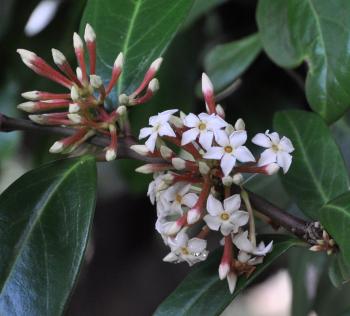
Description
Description
Evergreen to semi-deciduous shrub or small tree, 2–7 m, sometimes up to 15 m tall, with randomly sized stems of about 230 mm in diameter, with dark brown to greyish, rough bark and erect branches.

Leaves simple, lanceolate and narrowing at both ends with pointed apex and sometimes rounded, 60–120 × 15–60 mm, glossy, dark green above and pale green below, leathery and thick and raised main vein, with entire leaf margins; petiole short, up to 10 mm long. Flowers in dense clusters in leaf axils, white with shades of pink below; corolla tube slender, up to 20 mm long; petals 5–7 mm long. Flowering in spring to early summer (August to November).
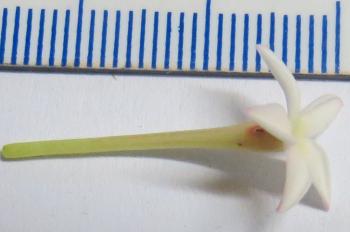
The fruit is oval to almost rounded, 25 mm long, red to purplish and black when ripe, fleshy, and long lasting, from spring to autumn (September to April). Seeds are translucent and recalcitrant (seeds that do not survive drying and freezing during storage), white, and shaped like a turtle shell.
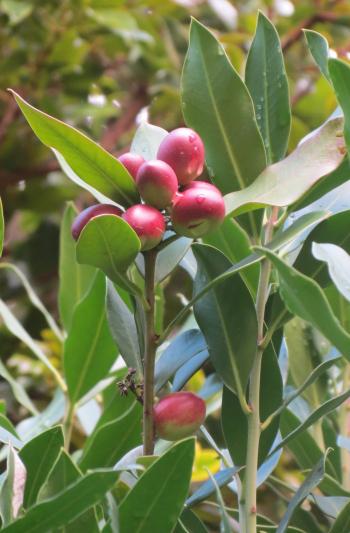
Conservation Status
Status
Acokanthera oblongifolia has not been selected for assessment in any of the four screening processes for potential conservation concern, therefore this species has received an automated status of Least Concern (LC)
Distribution and habitat
Distribution description
The genus is widely distributed from the Cape to Arabia. This species, Acokanthera oblongifolia, grows in the coastal dune forest from the Eastern Cape to KwaZulu-Natal, and in Swaziland, and to Maputo in Mozambique. Growing on the forest margins, often not so far from the sea, at 1 000–2 400 m altitude, in areas with an annual rainfall of 600–1 000 mm, it thrives in rocky, red clay and clay-loam soils. It is usually found on rocky escarpments, in forest edges, coastal bush, forest understory and often in open woodlands.
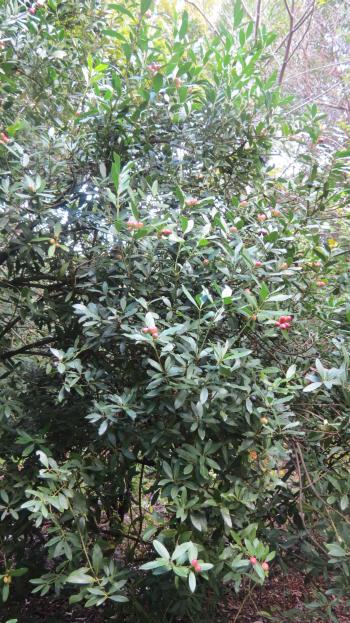
Derivation of name and historical aspects
History
The family name Apocynaceae is derived from the Greek words apo, meaning ‘away from’ or ‘after’ and kyon, meaning ‘a dog’, hence the old common name ‘poisonous to dogs’. The genus name Acokanthera is also derived from Greek and refers to the sharp or pointed anthers of the flowers. The species name oblongifolia, refers to the ‘oblong’ shape of the leaves, describing an elliptic leaf with adjacent sides equal.
There are 480 genera and 4800 species in the Apocynaceae, with 94 genera and 787 species in the Flora of southern Africa . The genus Acokanthera comprises 5 species and is restricted to Africa, except for one species that is also found in Yemen. Only 3 species occur in South Africa. Acokanthera belongs in the same family as many well-known garden plants such as Carissa (num-num), Plumeria (frangipani) and Nerium (oleander). Their distinctive characteristics are: sweetly scented flowers, often with leathery tough leaves and milky sap.
A. oblongifolia is closely related, similar to and often mistaken with A. oppositifolia. The distinctive characteristic that separates the two is that the leaves of A. oppositifolia are, as the name suggests, arranged oppositely and are decussate, whereas A. oblongifolia leaves are sub-oppositely arranged (personal observation).
The remaining two species occurring in South Africa are:
Acokanthera oppositifolia, the common poison-bush, which occurs on the coastal dunes, as A. oblongifolia does, but also grows further inland into the Limpopo, North West and Gauteng Provinces.
Acokanthera rotundata, the round-leaf poison-bush, which occurs in dry wooded areas in bushveld in KwaZulu-Natal and Limpopo Provinces, and in Swaziland, Mozambique and Zimbabwe.
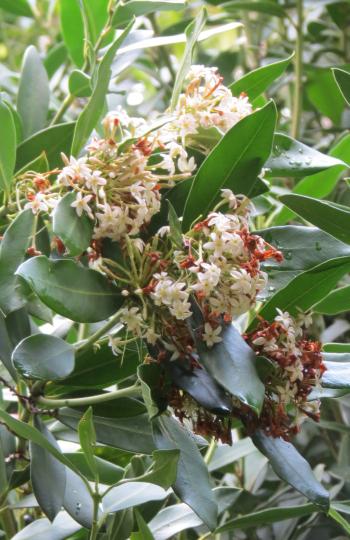
Ecology
Ecology
Because of the sweet scent of the flowers, A. oblongifolia is suspected to be pollinated by moths.
Uses
Use
Acokanthera oblongifolia is a highly poisonous and deadly plant hence the common name, dune poison-bush, and can kill within minutes when ingested or when sap enters into the blood stream. All parts of this tree are toxic including the fruit, especially when it is unripe. The toxin consists of cardiac glycosides which slow down the rate of the heartbeat (Roodt 1998). A. oblongifolia sap has been used in homicide, murders and suicides and as an arrow poison for hunting animals in the olden days, and marauding dogs have been killed with this poison. It has been traditionally used as a medicine to treat snake and spider bites.
It is a charming, decorative, dark green bush or tree, with attractive but very poisonous fruits that one might think are edible, as are those of Carissa macrocarpa, the num-num or Natal plum, which is in the same family and which has non-poisonous, edible fruits. This tree can be planted in a pot, best away from young children and pets, and can also be planted in garden beds as background filler.
Growing Acokanthera oblongifolia
Grow
This tree can be planted in coastal gardens, as it can withstand the salty winds and spray from the sea and also does well in inland gardens, as it is drought and shade tolerant, and frost resistant. Dune poison-bush can be propagated by means of sexual propagation (seed) and asexual propagation (clonal cuttings). When propagating by seed, use fresh seeds and prepare a seed tray with coarse bark at the bottom and fill the tray with river sand. Treating the seeds to prevent damping off, is not necessary. Spread the seeds on the surface of the sand, then cover lightly with sand, water and place in a warm, humid area and keep moist. Germination should take place within 4 to 5 weeks, but sometimes it takes longer. Once the first 3 sets of true leaves have formed, transplant to 9 cm nursery pots and apply a suitable slow release fertiliser to promote growth.
The dune poison bush is potentially extremely dangerous; therefore it is highly recommended that when propagating this tree, one takes caution, as all plant parts are poisonous. Use latex gloves as a safety precaution to prevent skin contact with the milky sap. In preparation for propagation have latex gloves, secateurs, a sterilising agent, rooting hormone, a seed tray or nursery plug tray and a mixture of river sand, fine bark. Then you are ready to plant! Take semi hardwood cuttings from a pest- and disease-free mother stock, at the coolest time of day, preferably in the morning or afternoon. Use a seed tray or plug tray, use a well-drained rooting mixture of fine bark, silica grit and perlite and water well. Rooting should take place within 5 to 6 weeks.
References
- Coates Palgrave, K. 2002. Trees of southern Africa. Struik, Cape Town.
- Dictionary of botanical epithets. http://www.winternet.com/~chuckg/dictionary.html
- Koekemoer, M., Steyn, H.M. & Bester, S.P. 2015. Guide to Plant Families of southern Africa. Strelitzia 31. 2nd ed., 2nd print. South African National Biodiversity Institute, Pretoria, South Africa.
- Plants of southern Africa: an online checklist. http:posa.sanbi.org. Accessed 4/07/2017
- Pooley, E. 1993. The complete field guide to trees of Natal, Zululand and Transkei. Natal Flora Publication Trust, Durban.
- Raimondo, D. et al. 2009. Red list of South African plants. Strelitzia 25. SANBI (South African National Biodiversity Institute), Pretoria.
- Roodt, V. 1998. Trees and shrubs of the Okavango Delta. The shell field guide series; part 1. Briza, Pretoria, South Africa.
Credits
Mpendulo Gabayi
Kirstenbosch National Botanical Garden
July 2017
Plant Attributes:
Plant Type: Shrub, Tree
SA Distribution: Eastern Cape, KwaZulu-Natal
Soil type: Sandy, Clay, Loam
Flowering season: Spring, Early Summer, Winter
PH:
Flower colour: White, Pink
Aspect: Full Sun, Shade, Morning Sun (Semi Shade), Afternoon Sun (Semi Shade)
Gardening skill: Average
Special Features:
Horticultural zones








Rate this article
Article well written and informative
Rate this plant
Is this an interesting plant?
Login to add your Comment
Back to topNot registered yet? Click here to register.